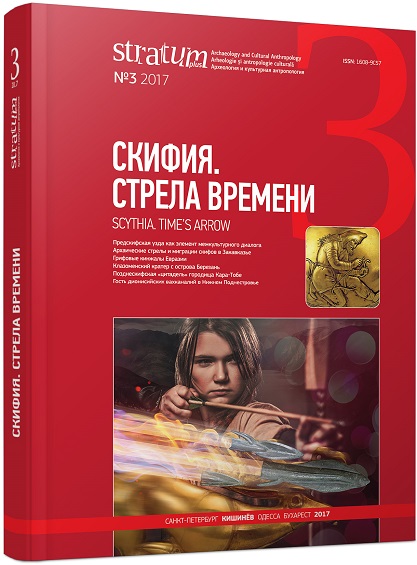Клазоменский чернофигурный кратер из Борисфена
Clazomenian Black Figured Crater from Borysthenes
Author(s): Alla BujskikhSubject(s): Archaeology, Fine Arts / Performing Arts, Cultural history, Visual Arts, Ancient World
Published by: Издательский дом Stratum, Университет «Высшая антропологическая школа»
Keywords: Klazomenai; Olbia; Berezan Island; archaic period; black figured style; Borysthenes group
Summary/Abstract: Paper is devoted to publication of black figured Clazomenian crater found in 1974 in Borysthenes by V. V. Lapin. Multi-frieze painting is made on white slipping with incised lines and added colours; main subject is a religious fest or agon. Rim is decorated with triple cable, its outer part — with hunting and animal struggle; under the rim — lotus garland, beneath — dancing comasts, riders, charioteers, an apobat. Central frieze contains the depiction of two women playing kitharas and six women holding the hands and dancing. Pair of riders and a cavalcade is visible at lower frieze. Stylistic analysis shows the closest iconographic connection with Middle Corinthian tradition. Besides of them the influences of Attica, Chios and Aeolia are present, but in lesser number. The peculiarities of painting permitted to abandon its former interpretation like a precursor of Clazomenian style and to propose it in a company with samples from Borysthenes, Olbia and Panticapaion — to create a new Borysthenes group. This group is considered to be the earliest in Clazomenian vase painting, it opens formation of Clazomenian black figured style. Tübingen Group (by R. Cook) followed this group. A starting point of Borysthenes group must by synchronous to the top of the Middle Corinthian, after 580s BC; indeed, it existed during 15—20 years. The Tübingen Group, the successor, had to appear after 560s BC, without chronological lacunae.
Journal: Stratum plus. Археология и культурная антропология
- Issue Year: 2017
- Issue No: 3
- Page Range: 155-179
- Page Count: 25
- Language: Russian
- Content File-PDF

